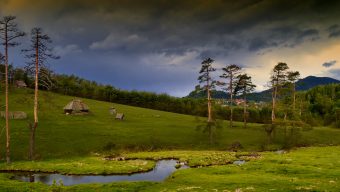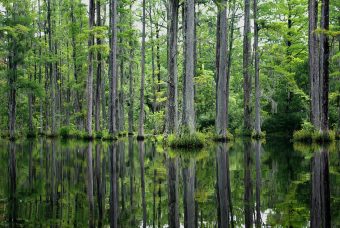
This month, world leaders and experts convened for the UN General Assembly which is culminating in the UN Summit on Biodiversity today. The Summit will emphasise the need to safeguard nature and drive momentum towards the post-2020 Biodiversity Framework. Last year, the UN Summit on Climate, also convened during UNGA, focused on addressing the climate emergency.
Just as our societies and economies are inextricably linked with and dependent on biodiversity, nature loss and climate change are also linked – and great benefits for people and planet can be achieved if they are tackled together. The COVID-19 pandemic has made an even stronger case for a fundamental shift towards net-zero, nature-positive economies.
The health crisis is a stark reminder of the devastating consequences of overlooking biophysical risks on human wellbeing, businesses and economies. We must urgently and deliberately seize the narrowing window of opportunity to avoid such crises in the future.
As we reach irreversible tipping points for both nature and climate, the time to act is now. Over half of the world’s GDP is moderately or highly dependent on nature and, in 2020, the World Economic Forum ranked climate change as the biggest risk to economy and society. Business-as-usual is no longer good for business.
More:
The safeguarding of natural ecosystems is crucial if we are to meet both biodiversity and climate goals. Stopping deforestation and restoring forests, for example, is one of the best options available to halt climate change; it also brings vast benefits for biodiversity. Such win-win scenarios are central to nature-based solutions and natural climate solutions.
Nature-based solutions are gaining popularity among governments and businesses alike to address environmental threats and solve societal problems by protecting, restoring and sustainably managing ecosystems. They are also a powerful tool against climate change and could provide 37 percentage of the cost-effective CO2 mitigation needed by 2030 in order to stay below 2°C of warming. Natural climate solutions are related but have the specific aim of reducing carbon emissions and increasing the carbon stock in natural ecosystems such as forests and wetlands.
The way in which decarbonization efforts are planned can either help or hinder the reversal of nature loss. In order to reach climate goals, it is estimated that wind and solar must provide almost all new electricity generation capacity between now and 2040. However, the development of such technologies could pose a risk to critical natural ecosystems if not designed with nature in mind. Vast areas of land and sea will be needed to transition to renewable energy and, by some estimates, the production of some metals will need to increase 12-fold by 2050 in order to meet the Paris Agreement’s climate goals.

Some companies are already addressing this issue. Elion, a Chinese salt chemical engineering business, committed to using only renewable energy as well as to ensuring that the land on which solar panels are built is restored and biodiverse. This model is called “eco-restoration and wealth creation”.
As outlined in The Future of Nature and Business Report, there are significant economic gains to be made by transitioning to a nature-positive economy, amounting to $3.5 trillion in additional annual business revenues or cost savings and 87 million new jobs by 2030 in the energy and extractives system alone.
Nature-based solutions can increase the resilience of businesses and livelihoods. For example, Nestlé is using the approach to restore ecosystems and preserve water resources. Its reforestation programme plants trees throughout its supply chain, using an agroforestry approach, which contributes to biodiversity, stores carbon and provides water and nutrients to the crops around them. Farmers implementing this approach with Nestlé, therefore, use less water, achieve greater crop yields and are more resilient to extreme weather events.
Similarly, Unilever, as a part of its commitment to stop deforestation, is working to restore and expand forested areas to “prevent the worst impacts of climate change and safeguard the world’s biodiversity”, in five different landscape programmes across Indonesia and Malaysia. Since 2018, Kering has partnered with Savory to pioneer nature-based solutions for regenerative agriculture in fashion, an industry which, if nothing changes by 2050, will use up one-quarter of the world’s carbon budget and significant amounts of land and water.
Nature-based solutions should form part of the strategy of any forward-thinking organisation looking to reduce their impact on nature and climate and take advantage of the business opportunities of a nature-positive, net-zero economy.
Investing in nature to tackle climate change
Natural climate solutions are also gaining traction in policy and business. Such solutions are proven ways of reducing carbon emissions and storing more carbon in the landscape. The EU’s recently announced Green Deal combines safeguarding nature and reducing carbon emissions to create a sustainable and inclusive growth strategy by implementing approaches such as regenerative agroforestry.

Pharmaceutical giant Bayer has taken steps to make carbon sequestration a crop opportunity for farmers. Bayer rewards growers who generate carbon credits by adopting climate-smart practices and creating a new on-farm revenue stream. Shell also believes that natural solutions can make a big contribution to their net-zero emissions by 2050 strategy. In June 2020, Amazon announced a $2 billion Climate Pledge Fund to invest in companies building products, services, and technologies to decarbonise the economy and protect the planet.
Natural climate solutions are often complex and interconnected and can deliver significant adaptation and mitigation benefits. The Natural Climate Solutions Alliance at the World Economic Forum is working to scale-up affordable natural climate mitigation solutions to help achieve the goals of the Paris Agreement.
Restoring and preserving nature can help us fight the twin crises of nature loss and climate change. Addressing these issues together, however, offers wide benefits beyond the obvious reduction in carbon emissions and increases in plant and animal varieties. Doing so would strengthen the resilience of our societies and jobs in the face of environmental, economic and health shocks, as well as improve water and food security.
Governments and businesses alike must promote action that supports biodiversity and natural ecosystems in addition to reducing climate change and its impact.
The benefits of natural solutions are not insignificant and could enable us to build back better. Transitioning to a nature-positive economy could generate up to $10 trillion in additional annual business revenue and cost savings and create 395 million new jobs by 2030. While the integration of climate change and nature in COVID recovery packages is still not as widespread or consistent as it should be, the message is clear: we must not solve problems of today with solutions that create problems for tomorrow.
Investing in nature holds the key.
Source: WEF



